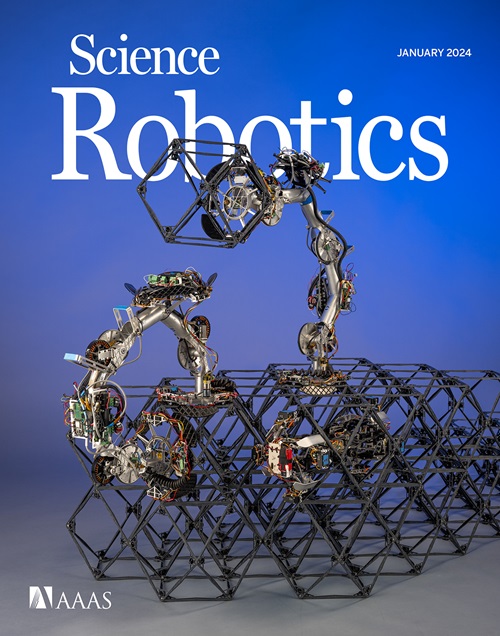Head-mounted surgical robots are an enabling technology for subretinal injections
IF 27.5
1区 计算机科学
Q1 ROBOTICS
Science Robotics
Pub Date : 2025-02-19
引用次数: 0
Abstract
Therapeutic protocols involving subretinal injection, which hold the promise of saving or restoring sight, are challenging for surgeons because they are at the limits of human motor and perceptual abilities. Excessive or insufficient indentation of the injection cannula into the retina or motion of the cannula with respect to the retina can result in retinal trauma or incorrect placement of the therapeutic product. Robotic assistance can potentially enable the surgeon to more precisely position the injection cannula and maintain its position for a prolonged period of time. However, head motion is common among patients undergoing eye surgery, complicating subretinal injections, yet it is often not considered in the evaluation of robotic assistance. No prior study has both included head motion during an evaluation of robotic assistance and demonstrated a significant improvement in the ability to perform subretinal injections compared with the manual approach. In a hybrid ex vivo and in situ study in which an enucleated eye was mounted on a human volunteer, we demonstrate that head-mounting a high-precision teleoperated surgical robot to passively reduce undesirable relative motion between the robot and the eye results in a bleb-formation success rate on moving eyes that is significantly higher than the manual success rates reported in the literature even on stationary enucleated eyes.
头戴式手术机器人是视网膜下注射的使能技术
包括视网膜下注射在内的治疗方案有望挽救或恢复视力,但对外科医生来说是一个挑战,因为它们处于人类运动和感知能力的极限。注射导管在视网膜上的压痕过多或不足,或导管相对于视网膜的运动可导致视网膜创伤或治疗产品的不正确放置。机器人辅助可以使外科医生更精确地定位注射套管,并在较长时间内保持其位置。然而,头部运动在接受眼科手术的患者中很常见,使视网膜下注射复杂化,但在评估机器人辅助时通常不考虑这一点。先前没有研究在评估机器人辅助时既包括头部运动,又证明与手动方法相比,在视网膜下注射的能力有显著提高。在一项体外和原位混合研究中,将一个去核的眼睛安装在一名人类志愿者身上,我们证明了头部安装一个高精度的远程手术机器人,以被动地减少机器人和眼睛之间的不良相对运动,结果是在移动的眼睛上形成水泡的成功率显著高于文献中报道的手动成功率,即使是在静止的去核的眼睛上。
本文章由计算机程序翻译,如有差异,请以英文原文为准。
求助全文
约1分钟内获得全文
求助全文
来源期刊

Science Robotics
Mathematics-Control and Optimization
CiteScore
30.60
自引率
2.80%
发文量
83
期刊介绍:
Science Robotics publishes original, peer-reviewed, science- or engineering-based research articles that advance the field of robotics. The journal also features editor-commissioned Reviews. An international team of academic editors holds Science Robotics articles to the same high-quality standard that is the hallmark of the Science family of journals.
Sub-topics include: actuators, advanced materials, artificial Intelligence, autonomous vehicles, bio-inspired design, exoskeletons, fabrication, field robotics, human-robot interaction, humanoids, industrial robotics, kinematics, machine learning, material science, medical technology, motion planning and control, micro- and nano-robotics, multi-robot control, sensors, service robotics, social and ethical issues, soft robotics, and space, planetary and undersea exploration.
 求助内容:
求助内容: 应助结果提醒方式:
应助结果提醒方式:


